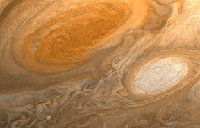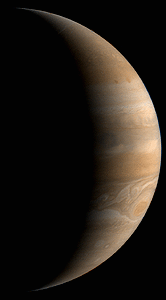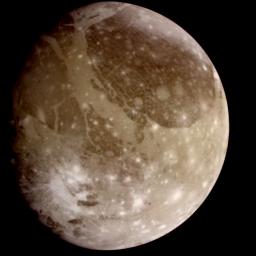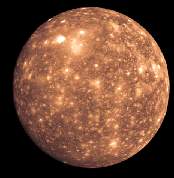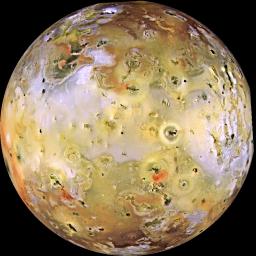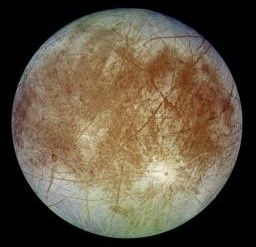Technical Data:-
| Diameter | 142,600 km |
| Average Distance from Sun | 778,412,010 km |
| Mass | 1.90 x 1027 kg |
| Size compared to Earth | 11x |
| Gravity compared to Earth | 2.34x |
| Surface Temperature | 165 K |
| Length of day | 9 hours 50 minutes |
| Length of year | 11.84 years |
| Eccentricity of Orbit | 0.048 |
| Density | 1.33 gm/cm3 |
| Moons | 63 |
| Atmosphere | Hydrogen - 90% Helium - 10% Traces of Methane & Ammoni |
| ................................................................................ ................................................................................ Brief History:- Galileo Galilei first discovered Ganymede, Callisto, Io and Europa in 1610 and some evidence suggests that he may have spotted the "Red Spot' on Jupiter over 380 years ago. In 1979, the Voyager space probe passed Jupiter and while it was passing, it noticed 9 active volcanoes on Io as well as discovering Jupiter's rings and taking 30,000 pictures. The Galileo space probe later comprehensively studied Jupiter and revealed a wealth ofknowledge, and also dropped a small probe into Jupiter's atmosphere. The Cassini space probe also studied Jupiter en-route to Saturn, giving us our most detailed images yet of the planet and its moons. ................................................................................ ................................................................................ A Planet of Superlatives... Within our Solar System, Jupiter is quite frankly a planet of superlatives. It is the biggest, mightiest, most impressive planet in our neighbourhood. It has two and a half times more mass than all of the other planets put together, and over 1000 times the volume of the Earth. In some ways, it even bears some similarities with a small star. Scientists calculate that in fact if Jupiter had been 50 times more massive than it is now, the pressure and temperature in its core would have been sufficient to start nuclear reactions, thus turning it into a star. Thankfully for us here on Earth however, this was not to be, and instead we are left with Jupiter as 'merely' the largest planet in the Solar System. However, Jupiter still appears fairly bright due to its size, and is the 4th brightest object in the night sky. It was because of this brightness that Galileo Galilei was able to spot this planet shortly after turning his newly refined telescope to the stars, from his home in Padova, in 1610. He also discovered what are now known as the four 'Galilean moons' of Jupiter: Io, Europa, Callisto and Ganymede, all of them rather unique in their own right. If you want to see Jupiter at night, it appears as a yellow-white disc in the night sky.
The stripes which are visible on Jupiter's surface are caused by streams of fast, powerful winds which blow at over 400mph alternately in opposite directions across the planet (along the east-west axe). These winds are thought to be mainly caused by the internal heat generated from within Jupiter, and they can rapidly change shape, within days or hours. Jupiter's atmosphere is thought to extend a long way down into the planet. Nonetheless, scientists believe that Jupiter does have a small, rocky core at its heart, surrounded by an inner mantle of metallic liquid Hydrogen, and an outer one of 'normal' liquid Hydrogen and Helium. Under the kinds of enourmous pressures generated in the heart of Jupiter, Hydrogen is compressed to such an extent that it turns into liquid metallic Hydrogen (ie a mass of ionized protons and electrions).
Despite having a diameter 11 times bigger than the Earth's, Jupiter spins on its axis faster than any other planet in the Solar System. This is why it bulges out at the equator. This rapid spinning is also thought to contribute to the powerful wind systems which form the clearly visible 'bands' on Jupiter's surface discussed above. Other than the Sun, Jupiter is the largest emitter of heat in the Solar System. It is thought that this heat is energy left over from the high-temperature formation of the planet. Radiation is slowly emitted in the infra-red, and causes the planet to gradually decrease in volume, albeit by an insignificantly tiny amount. Jupiter's thin line of rings were only discovered by the Voyager 1 space probe in the late 1970's. They are 5920 kilometres wide and 1 km thick. This was a totally unexpected discovery and more recently it has been discovered there are in fact 3 sets of rings. At the last count, Jupiter had 63 moons. The first-discovered few are: Metis, Adrastea, Amalthea, Thebe , Io, Europa, Ganymede, Callisto, Leda, Himalia, Lysithea, Elara, Ananke, Carme, Pasiphae and Sinope. Click here to go to the Io section, for more information and pictures of Jupiter's most explosive moon - Io. Here is a summary of Jupiter's Galilean moons:
|

